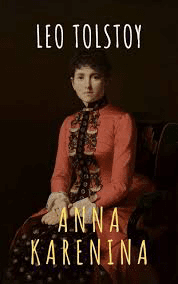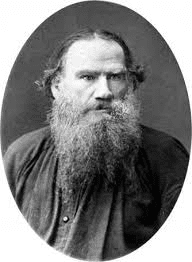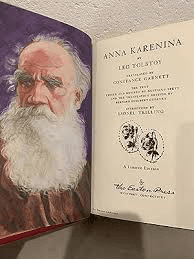Introduction: Overview of Leo
Tolstoy and his significance in literature

Source: Storytel
Anna Karenina Tolstoy’s Magnum Opus has great relevance even today. Leo Tolstoy, one of the most prominent literary figures of the 19th century, remains an indelible mark on the world of literature. Born on September 9, 1828, in Yasnaya Polyana, Russia, Tolstoy belonged to a noble family but was deeply influenced by the lives of peasants on his family’s estate, which would later inform his literary works.
Tolstoy’s significance in literature stems from his unparalleled ability to delve into the depths of human psyche and societal dynamics. His novels are celebrated for their profound philosophical insights, intricate character portrayals, and richly detailed narratives. Among his notable works are “War and Peace” and “Anna Karenina,” both considered masterpieces of world literature.
“War and Peace,” published between 1865 and 1869, is a sprawling epic that chronicles the lives of Russian aristocrats during the Napoleonic Wars. It is celebrated for its vivid depiction of historical events, its exploration of themes such as fate and free will, and its profound philosophical reflections on the nature of war and peace.
Anna Karenina Tolstoy’s Magnum Opus, published in serial installments from 1873 to 1877, is a poignant tale of love, adultery, and societal expectations in 19th-century Russia. Tolstoy’s meticulous characterizations and his exploration of moral dilemmas continue to captivate readers worldwide, cementing the novel’s status as one of the greatest works of literature ever written.
“Anna Karenina” as Tolstoy’s masterpiece:

Source: Medium
“Anna Karenina” stands as Leo Tolstoy’s magnum opus, a literary masterpiece that continues to captivate readers with its profound exploration of human emotions, societal norms, and moral dilemmas. Published in serial form between 1873 and 1877, this novel remains a timeless classic that resonates across generations.
At its core, Anna Karenina Tolstoy’s Magnum Opus tells the story of the eponymous Anna, a married aristocrat who embarks on a passionate affair with the dashing Count Vronsky, defying the conventions of her time and society. Set against the backdrop of 19th-century Russia, Tolstoy weaves a tapestry of interconnected lives, portraying the complexities of love, desire, and duty.
What sets “Anna Karenina” apart as a masterpiece is Tolstoy’s unparalleled skill in crafting characters that feel undeniably human, flawed yet profoundly relatable. From the tormented Anna to the idealistic landowner Levin, each character is imbued with depth and nuance, making their struggles and triumphs feel achingly real.
Setting the scene: Russia in the 19th century
Setting the scene in Anna Karenina Tolstoy’s Magnum Opus, Russia in the 19th century emerges as a character in its own right, deeply influencing the lives and choices of the novel’s protagonists. Against the backdrop of Tsarist Russia, societal norms and class distinctions reign supreme, shaping the behavior and expectations of individuals across all strata of society.
The vast expanse of the Russian countryside, with its sprawling estates and harsh winters, serves as a stark contrast to the opulent salons of St. Petersburg and Moscow, highlighting the disparities between urban and rural life. Moreover, the political upheaval of the era, marked by the abolition of serfdom and the rise of revolutionary fervor, adds an undercurrent of tension and uncertainty to the narrative. Through his richly detailed portrayal of 19th-century Russia, Tolstoy invites readers to immerse themselves in a world that is both familiar and foreign, providing a nuanced understanding of the forces that shape the characters’ destinies.

Tolstoy’s observations of Russian society
Tolstoy’s keen observations of Russian society in Anna Karenina Tolstoy’s Magnum Opus reveal a profound understanding of its complexities and contradictions. Through his characters and their interactions, Tolstoy exposes the hierarchical structure of Russian society, characterized by rigid class distinctions and entrenched aristocratic privilege.
He scrutinizes the hypocrisy of a society that upholds traditional values while harboring secrets and indulging in scandalous affairs. Moreover, Tolstoy delves into the psyche of the Russian elite, revealing their insecurities, desires, and existential struggles beneath a façade of refinement and decorum. From the lavish ballrooms of the aristocracy to the humble dwellings of the peasantry, Tolstoy’s portrayal of Russian society is both sweeping and intimate, offering a panoramic view of a world on the brink of change.
Sociopolitical backdrop and its influence on the narrative

Source: AbeBooks
The sociopolitical backdrop of 19th-century Russia casts a profound influence on the narrative of Anna Karenina Tolstoy’s Magnum Opus. Against the backdrop of a nation in flux, marked by the aftermath of serf emancipation and simmering revolutionary sentiments, Tolstoy weaves a tale that reflects the tensions and uncertainties of the era. The rigid social hierarchy and conservative values of Russian society serve as a crucible for the characters’ struggles, shaping their choices and destinies.
Moreover, the political upheaval of the time underscores the themes of morality, duty, and individual freedom that permeate the novel. Through his nuanced exploration of the sociopolitical landscape, Tolstoy invites readers to consider the interplay between personal and societal forces, shedding light on the complexities of human nature within the broader context of history.
Plot Summary: Overview of the main plotlines and characters: Anna Karenina Tolstoy’s Magnum Opus
Anna Karenina Tolstoy’s Magnum Opus unfolds with a rich tapestry of interconnected plotlines and compelling characters. At its heart is the titular character, Anna, a passionate and complex woman trapped in a loveless marriage. Her illicit affair with the dashing Count Vronsky drives much of the narrative, leading to a tragic unraveling of her life. Alongside Anna, we follow the story of Konstantin Levin, a landowner grappling with existential questions and searching for meaning in life. Levin’s journey serves as a counterpoint to Anna’s tumultuous romance, offering insights into themes of faith, work, and family.
Surrounding these central figures are a host of secondary characters, each with their own desires, struggles, and moral dilemmas. From the noble Karenin to the innocent Kitty and the rakish Vronsky, Tolstoy paints a vivid portrait of Russian society, capturing the complexities of human relationships and the collision of personal desires with societal expectations.
Key themes: love, societal norms, and morality
Anna Karenina Tolstoy’s Magnum Opus skillfully intertwines key themes such as love, societal norms, and morality, which reverberate throughout the narrative, shaping the characters’ choices and fates. Love, portrayed in its myriad forms, serves as both a driving force and a source of anguish for the characters. Anna and Vronsky’s passionate affair challenges societal conventions and moral boundaries, illustrating the power of love to defy social expectations. Meanwhile, Levin’s search for genuine love and connection leads him on a journey of self-discovery, culminating in his embrace of family life and spiritual fulfillment.
Against the backdrop of rigid societal norms, the novel explores the tensions between individual desires and collective expectations. Anna’s rebellion against the confines of marriage and class exposes the hypocrisy of a society that prizes appearances over authenticity, while Levin’s struggles with societal pressures highlight the quest for personal integrity amidst societal conformity.
Morality, in Anna Karenina Tolstoy’s Magnum Opus is depicted as a complex and subjective concept, with characters grappling with the consequences of their actions and the conflicting demands of duty and desire. Anna’s tragic fate serves as a cautionary tale, underscoring the moral ambiguity of human behavior and the devastating consequences of moral transgression. Through its exploration of these themes, “Anna Karenina” offers a profound meditation on the human condition, inviting readers to ponder the nature of love, the constraints of society, and the eternal struggle between right and wrong.
The tragic ending and its implications
The tragic ending of “Anna Karenina” casts a shadow over the entire narrative, leaving a profound impact on both the characters and the readers. Anna’s death by suicide, throwing herself under a train, serves as the culmination of her downward spiral, driven by societal condemnation, guilt, and despair. Her tragic demise underscores the consequences of her defiance of societal norms and moral codes, highlighting the destructive power of passion unrestrained by reason.
Moreover, Anna’s death reverberates beyond her individual fate, echoing the broader themes of the novel. It serves as a stark reminder of the limitations imposed by society on individual freedom and expression, and the price one pays for deviating from prescribed roles and expectations.
Furthermore, Anna’s tragic end prompts reflection on the nature of happiness and fulfillment, raising questions about the possibility of finding meaning and redemption in a world fraught with moral ambiguity and social constraints. Ultimately, the tragic ending of Anna Karenina Tolstoy’s Magnum Opus leaves a haunting impression, compelling readers to confront the complexities of human nature and the inexorable march of fate.
Anna Karenina: Complexities of her character and motivations
Anna Karenina, the central character of Tolstoy’s masterpiece, is a woman of profound complexity, her character and motivations woven intricately throughout the narrative. Initially introduced as a woman of grace and charm, Anna’s inner turmoil becomes increasingly evident as the story progresses.
Her motivations stem from a deep yearning for love and fulfillment, yet they are also driven by societal expectations and pressures. Trapped in a loveless marriage to Karenin, Anna seeks solace and passion in her affair with Vronsky, but her pursuit of happiness leads her down a path of self-destruction.
Despite her intelligence and sophistication, Anna is plagued by insecurities and contradictions, torn between her desire for freedom and her fear of societal condemnation. Her actions are driven by a complex interplay of emotions—love, guilt, shame, and longing—making her a deeply human and relatable character. Ultimately, Anna’s tragic fate serves as a testament to the complexities of the human heart and the devastating consequences of inner conflict and societal constraints.
Other central characters: Levin, Kitty, Vronsky, etc.
In addition to Anna Karenina, Leo Tolstoy populates his novel with a rich array of central characters, each with their own distinctive traits, motivations, and story arcs. Konstantin Levin, a landowner and philosophical thinker, serves as a foil to Anna’s passionate turmoil. Levin grapples with questions of faith, work, and the pursuit of happiness, embarking on a journey of self-discovery that parallels Anna’s own quest for fulfillment.
His courtship of Kitty, Anna’s sister-in-law, forms a central subplot in the novel, showcasing the transformative power of love and the challenges of navigating societal expectations.
- Kitty, initially infatuated with Vronsky, undergoes a profound evolution as she comes to understand the true nature of love and maturity. Her rejection by Vronsky and subsequent marriage to Levin symbolize her growth from a naïve young girl into a resilient and mature woman, offering a contrast to Anna’s tragic descent.
- Count Alexei Vronsky, the object of Anna’s affections, is a dashing and charismatic officer whose passion for Anna sets off a chain of events that reverberate throughout the novel. His character embodies the allure of forbidden love and the consequences of yielding to desire, as he grapples with the guilt and responsibility of his role in Anna’s downfall.
- Throughout the novel, Tolstoy masterfully interweaves the lives of these central characters, exploring themes of love, morality, and the pursuit of happiness in a society marked by rigid social norms and personal ambitions. Each character’s journey offers unique insights into the human condition, enriching the tapestry of “Anna Karenina” with depth, nuance, and emotional resonance.
Character development and relationships: Anna Karenina Tolstoy’s Magnum Opus
“Character development and relationships” in Anna Karenina Tolstoy’s Magnum Opus are central to Leo Tolstoy’s exploration of the human condition and societal dynamics. Throughout the novel, Tolstoy meticulously traces the evolution of each character, illuminating their inner struggles, growth, and relationships with others.
One of the most striking examples of character development is seen in Konstantin Levin, whose journey from existential doubt to personal fulfillment serves as a counterpoint to Anna’s tragic arc.
Levin’s introspective nature and philosophical inquiries lead him on a path of self-discovery, as he grapples with questions of faith, work, and love. His relationship with Kitty, from initial infatuation to mature companionship, reflects his own emotional and spiritual growth.
Similarly, Anna Karenina undergoes profound character development, albeit in a tragic direction. Initially portrayed as a glamorous and confident woman, Anna’s inner turmoil and dissatisfaction with her marriage propel her into a passionate affair with Vronsky.
As the novel progresses, Anna’s descent into despair and paranoia exposes the fragility of her psyche and the destructive consequences of her actions.
The relationships between characters in Anna Karenina Tolstoy’s Magnum Opus are equally complex and multifaceted. Anna’s affair with Vronsky, fraught with passion and guilt, reverberates through the lives of those around them, exposing the fragility of human bonds and the consequences of moral transgression.
Meanwhile, Levin and Kitty’s marriage serves as a beacon of stability and mutual support, grounded in genuine affection and shared values.
Through his nuanced portrayal of character development and relationships, Tolstoy invites readers to ponder the intricacies of human nature and the complexities of interpersonal dynamics.
From love and betrayal to duty and redemption, the characters of “Anna Karenina” navigate a rich tapestry of emotions and experiences, offering profound insights into the human condition.
Themes and Messages: Love, passion, duty, sacrifice
Anna Karenina Tolstoy’s Magnum Opus delves deeply into the theme of love and its multifaceted nature, portraying it in various forms including passion, duty, and sacrifice. Throughout the novel, Leo Tolstoy illustrates the intoxicating allure of passionate love through the tumultuous affair between Anna and Vronsky, which defies societal conventions and moral boundaries.
However, alongside this fervent passion, Tolstoy also explores the quieter, enduring love found in the relationships of characters like Levin and Kitty, which are built on mutual respect and commitment.
Additionally, Anna Karenina Tolstoy’s Magnum Opus delves into the theme of duty and sacrifice, as characters grapple with the conflicts between their personal desires and their responsibilities to family, society, and themselves.
Through these intricate themes, Tolstoy crafts a poignant narrative that illuminates the complexities of human emotions and the choices individuals make in the pursuit of love and fulfillment.
Critique of societal norms and expectations
Anna Karenina Tolstoy’s Magnum Opus serves as a powerful critique of societal norms and expectations prevalent in 19th-century Russian society. Leo Tolstoy meticulously exposes the hypocrisy and rigidity of these norms, revealing how they stifle individual freedom and authenticity.
Through characters like Anna, who rebels against the constraints of her loveless marriage and society’s expectations, Tolstoy highlights the suffocating effects of societal conventions on personal happiness.
Similarly, Levin’s struggles with societal pressures to conform to traditional roles reflect Tolstoy’s commentary on the stifling nature of societal expectations.
Through these critiques, Tolstoy invites readers to question the validity of societal norms and to consider the consequences of blindly adhering to them, urging individuals to pursue authenticity and self-discovery despite societal pressures.
Moral dilemmas and consequences of choices
“Moral dilemmas and consequences of choices” are central themes in Anna Karenina Tolstoy’s Magnum Opus, illuminating the complexities of human behavior and the repercussions of our decisions.
Leo Tolstoy presents characters grappling with ethical quandaries, torn between conflicting duties, desires, and societal expectations. Anna’s affair with Vronsky, for instance, forces her to navigate the moral implications of betraying her marriage vows and societal norms, ultimately leading to her tragic downfall.
Similarly, Levin faces moral dilemmas as he seeks meaning and purpose in his life, struggling to reconcile his philosophical ideals with the practicalities of daily existence. Through these moral quandaries,
Tolstoy prompts readers to consider the ethical dimensions of their own choices and the far-reaching consequences that may result, underscoring the timeless relevance of moral introspection and ethical decision-making.
Relevance of these themes in contemporary society
The themes explored in Anna Karenina Tolstoy’s Magnum Opus resonate deeply with contemporary society, highlighting enduring truths about the human condition. Love, societal norms, moral dilemmas, and the consequences of our choices are all themes that continue to shape our lives today.
In an age marked by shifting social values and evolving definitions of morality, the novel’s critique of societal norms serves as a poignant reminder to question the status quo and challenge oppressive conventions.
Moreover, the complexities of love portrayed in the novel—ranging from passionate desire to the sacrifices it demands—reflect the intricacies of modern relationships and the pursuit of happiness in an increasingly complex world. The moral dilemmas faced by characters like Anna and Levin prompt reflection on the ethical dimensions of our own choices, inviting readers to consider the implications of our actions on both ourselves and society at large.
Thus, the relevance of these themes in “Anna Karenina” transcends time, offering profound insights into the human experience that remain pertinent in contemporary society.
Tolstoy’s narrative techniques and storytelling prowess: Anna Karenina Tolstoy’s Magnum Opus
Tolstoy’s narrative techniques and storytelling prowess in Anna Karenina Tolstoy’s Magnum Opus are renowned for their depth and complexity. Through intricate character development, vivid imagery, and masterful pacing, Tolstoy immerses readers in the rich tapestry of 19th-century Russian society.
His use of omniscient narration allows for a panoramic view of the characters’ inner lives and external conflicts, enhancing the novel’s realism and emotional impact. Tolstoy’s attention to detail, from the lush descriptions of Russian landscapes to the nuanced portrayal of social interactions, creates a world that feels vibrant and alive. Through these techniques, Tolstoy crafts a narrative that is both timeless and profoundly captivating.
Use of symbolism, foreshadowing, and imagery
Anna Karenina Tolstoy’s Magnum Opus employs symbolism, foreshadowing, and imagery with masterful precision, enriching the narrative with layers of meaning and depth. Symbolism, such as the recurring motif of trains representing fate and inevitability, imbues the novel with thematic resonance and narrative cohesion. Foreshadowing subtly hints at the characters’ destinies, adding tension and suspense to the unfolding story.
Meanwhile, vivid imagery, from the picturesque Russian countryside to the opulent salons of St. Petersburg, enhances the novel’s realism and sensory appeal, immersing readers in its world. Through these literary devices, Tolstoy elevates “Anna Karenina” beyond a mere tale of love and tragedy, creating a work of enduring literary significance.
Impact of Tolstoy’s writing style on the reader’s experience: Anna Karenina Tolstoy’s Magnum Opus
Anna Karenina Tolstoy’s Magnum Opus profoundly impacts the reader’s experience, drawing them into a richly textured world of vivid imagery and deep introspection. His intricate prose and omniscient narration offer readers unparalleled access to the characters’ thoughts and emotions, fostering empathy and understanding.
Tolstoy’s attention to detail, from the lush descriptions of Russian landscapes to the minutiae of social interactions, creates an immersive experience that resonates long after the final page.
Furthermore, his philosophical musings on love, morality, and the human condition provoke thought and introspection, enriching the reader’s intellectual engagement with the text. Overall, Tolstoy’s writing style elevates “Anna Karenina” from a mere novel to a transformative literary experience.
Anna Karenina’s enduring legacy in literature: Anna Karenina Tolstoy’s Magnum Opus
Anna Karenina Tolstoy’s Magnum Opus endures as a timeless masterpiece in literature, leaving an indelible mark on readers and writers alike. Tolstoy’s exploration of love, morality, and societal norms transcends its 19th-century Russian setting, resonating across generations and cultures.
The complexity of its characters and the depth of its themes continue to captivate readers, offering new insights with each reading. Moreover, “Anna Karenina” has inspired countless adaptations, interpretations, and homages, further cementing its status as a literary classic.
Its enduring legacy lies in its ability to provoke thought, stir emotions, and illuminate the human condition with unparalleled depth and insight.
Why “Anna Karenina” remains a relevant and compelling read in the 21st century: Anna Karenina Tolstoy’s Magnum Opus
Anna Karenina Tolstoy’s Magnum Opus retains its relevance and allure in the 21st century due to its timeless exploration of universal themes and its profound understanding of the human psyche. Tolstoy’s insights into love, morality, and societal expectations transcend the novel’s 19th-century Russian setting, resonating with contemporary readers grappling with similar issues.
Moreover, the complexity of the characters and their moral dilemmas offers readers a mirror to reflect upon their own lives and choices. Additionally, the novel’s enduring legacy is bolstered by its rich narrative tapestry, intricate prose, and philosophical depth, making it a compelling read that continues to captivate and provoke thought in readers across cultures and generations.
Conclusion: Anna Karenina Tolstoy’s Magnum Opus
In conclusion, Anna Karenina Tolstoy’s Magnum Opus stands as a timeless masterpiece that transcends the boundaries of time and culture, offering readers profound insights into the complexities of the human condition. Through its rich narrative, intricate characters, and timeless themes, Leo Tolstoy’s magnum opus continues to captivate and resonate with readers in the 21st century. Its enduring relevance lies in its ability to provoke thought, evoke emotions, and spark conversations about love, morality, and societal norms.
As we delve into the pages of Anna Karenina Tolstoy’s Magnum Opus we are reminded of the enduring power of literature to illuminate the depths of human experience and to offer solace and understanding in an ever-changing world.
Recommended Book-

Also Read-
https://topupdates.info/best-indian-shows-on-netflix/
https://topupdates.info/it-starts-with-us/
https://topupdates.info/best-rbi-grade-b-books-2024/

5 thoughts on “Anna Karenina Tolstoy’s Magnum Opus: Wonderful Reading (2024)”